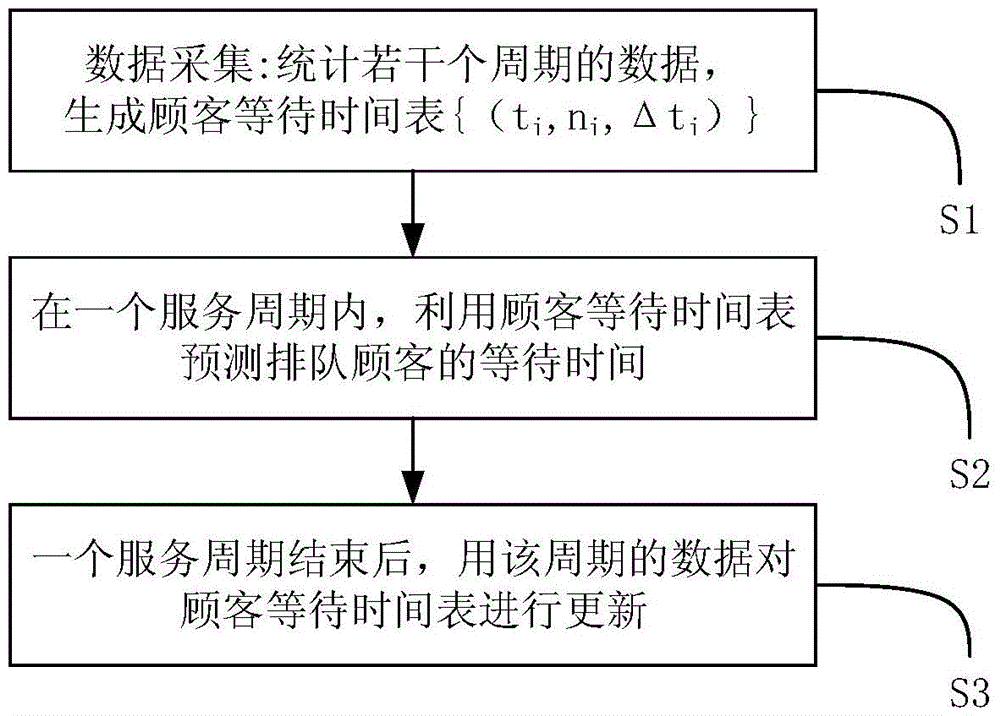Waiting time predicting method for queuing machine
A technology of waiting time and prediction method, which is applied in the field of control, and can solve the problems of inability to correct customer waiting time, influence of waiting time error, and low accuracy requirement of predicted waiting time
- Summary
- Abstract
- Description
- Claims
- Application Information
AI Technical Summary
Problems solved by technology
Method used
Image
Examples
Embodiment 1
[0055] Such as Figure 4 As shown, the device of this embodiment includes an input device, which is used to input the arrival time, length of arrival time, and real waiting time information of all historical customers in several historical service cycles before the customer's arrival; the information collection device is used to collect customer arrival information and queuing customers to receive service information; the data collection module is used to collect incoming customer information, and record the customer's arrival time, arrival team leader and real waiting time; the table automatic generation module is used to count all historical customer arrivals in a historical service cycle Time, arrival team leader and real waiting time, and generate a customer waiting schedule; calculation module, used to obtain data from the customer waiting schedule and calculate the time that arriving customers need to wait according to the data; detection module, used to obtain customer i...
Embodiment 2
[0062] This embodiment provides a method for predicting the waiting time of a queuing machine used in a restaurant, by inputting the data of each customer in the previous two historical service cycles (intercepting the period of 11:30-11:45 noon of the previous two days). arrival time t i , Captain n when reaching i and the real waiting time Δt i Input the data into the data acquisition module, and send the data to the form automatic generation module, and the form automatic generation module first generates the customer waiting time form {(t i ,n i ,Δt i )} (i is taken as a positive integer), and then use the data to fill the customer waiting time table, and when filling, for the time when no customer arrives, set the arrival time leader at this time as the arrival time leader of the previous customer, and the waiting time Set it as the waiting time of the last customer, and get the customer waiting time table of a historical cycle, see Table 1.
[0063] Table 1 Customer...
Embodiment 3
[0075]The difference between this embodiment and Embodiment 1 is that after the data collection module collects the historical data of 10 service cycles, the table automatic generation module generates a customer waiting timetable based on the 10 historical service cycles. After the customer waiting schedule is generated, the central processing unit detects whether the customer has arrived according to the (7) formula (X=1). When X=0, it means that there is no customer coming. =1) judge whether there are customers in line to receive service, when Y=0, no customers in line to receive service, this step of operation ends, return to check again whether there is customer arrival.
PUM
 Login to View More
Login to View More Abstract
Description
Claims
Application Information
 Login to View More
Login to View More - Generate Ideas
- Intellectual Property
- Life Sciences
- Materials
- Tech Scout
- Unparalleled Data Quality
- Higher Quality Content
- 60% Fewer Hallucinations
Browse by: Latest US Patents, China's latest patents, Technical Efficacy Thesaurus, Application Domain, Technology Topic, Popular Technical Reports.
© 2025 PatSnap. All rights reserved.Legal|Privacy policy|Modern Slavery Act Transparency Statement|Sitemap|About US| Contact US: help@patsnap.com



